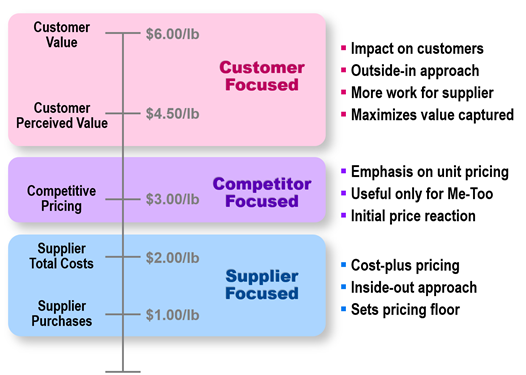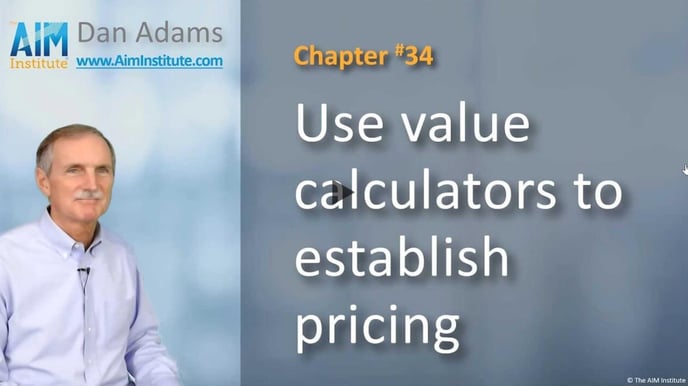Value calculators let you see the value your new product creates for customers... so you can properly price your product.
In our experience, most B2B new product teams do not build value calculators… but they should. And this is especially true if your team is creating a new product that delivers significant value. Why? The alternatives to creating a value calculator are truly awful.
Consider three ways to price your product:
- Supplier focused: This is often called cost-plus pricing. It’s an inside-out approach that almost always leaves money on the table. This type of thinking is useful only for understanding your pricing floor.
- Competitor-focused: This emphasizes unit pricing—dollars per pound or Euros per liter—not value created. It’s only useful for me-too and incremental new products—which you should not be developing with New Product Blueprinting.
- Customer-focused: This pricing is all about the economic impact on customers—what they will make or save with your new product. It’s an outside-in approach that requires more work for the you… but it’s the only way to maximize the value you capture with your new product.

We strongly recommend using customer-focused pricing… and value calculators are the mechanism for doing this. This is a complex subject, so we also suggest you review e-Learning Module 8: Creating & Capturing Value at www.blueprintingcenter.com > e-Learning Modules.
Before we leave the topic of your pricing alternatives… what about pricing surveys? There are tools such as Van Westendorp pricing surveys (discussed at the end of e-Learning Module 8) in which the supplier asks customers a series of questions to predict the optimal price point. Such tools are common for consumer goods, and could work for you if you have a fragmented market with thousands of customers.
But if your market is more concentrated with fewer customers, they simply won’t give you straight answers to these pricing questions. Why should they? They know they’ll be negotiating prices with you later, and they have no incentive to arm you with data. Bottom line: B2C producers ask for pricing decisions (with a survey) while most B2B producers try to understand price decision-making. If you’re in the latter group, this creates both a disadvantage and an advantage:
- B2B disadvantage: You’re going to have to work hard to enter the customer’s world so completely that you’ll be able to financially model their experience (with a value calculator).
- B2B advantage: Every time B2C producers have a new product concept, they must conduct another pricing survey. But you can use your financial model to run as many product design concepts as you’d like.
In order to set the right price for your new product, you must do two things:
- Understand value: You need to understand in quantitative terms how much value your new product delivers to customers. This could be in thousands or millions of dollars per year (for steady, annual benefits)… or a return on investment percentage (if an up-front investment or switching costs are required.)
- Communicate value: Your maximum price premium isn’t determined by the value your new product delivers. It’s set by the customers’ perception of that value. So your “second job” is to move customers’ perceived value as close as possible to the real value.
Good news: Value calculators help you accomplish both tasks.
You can download an Excel-based Value Calculator Example at www.blueprintingcenter.com > BlueTools > Skill-Building & Other Tools. Also check out the 2-minute video, Use value calculators to establish pricing, part of the B2B Organic Growth video series by Dan Adams.
Keywords: value calculator, customer value, value calculator example, new product pricing, understand customer value, communicate customer value, price decision-making, price decisions, customer perceived value

